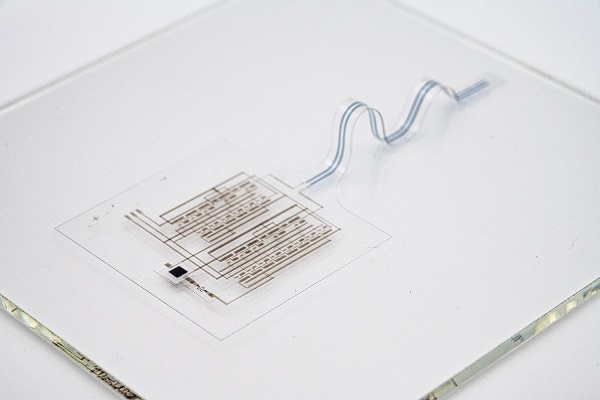Mechanoreceptors in human skin can sense the delicate weight of a butterfly, feel the heat of a nearby flame or a cool drink, understand whether a hand is raised in a fist or a peace sign, and count the pulse of a loved one with a gentle touch.
Engineers eager to create artificial electronic skin have so far been able to fashion soft, flexible materials that mimic each of these remarkable senses and researchers at Stanford University have now created a single sheet with skin-like materials that can directly talk to the brain.
While previous efforts required rigid electronics to convert the sensed signal into electrical pulses that the brain can read, the researchers have produced soft integrated circuits that convert sensed pressure or temperature to electrical signals similar to nerve impulses, to communicate with the brain. They hope that someday the signals might be directed to implanted wireless communication chips in the peripheral nerve to allow amputees to control prosthetic limbs. Other potential uses might include new-age implantable or wearable medical devices.
“We’ve been working on a monolithic e-skin for some time,” said Professor Zhenan Bao, who led the project. “The hurdle was not so much finding mechanisms to mimic the remarkable sensory abilities of human touch, but bringing them together using only skin-like materials.

The three layers of the e-skin contain networks of organic nanostructures that can be designed to sense pressure, temperature, strain and chemicals.
Complexity
“Much of that challenge came down to advancing the skin-like electronic materials so that they can be incorporated into integrated circuits with sufficient complexity to generate nerve-like pulse trains and low enough operating voltage to be used safely on the human body,” added Weichen Wang, a doctoral candidate in Bao’s lab.
The goal was a soft integrated circuit that could mimic the mechanism of sensory receptors and run efficiently at a low voltage.
Unfortunately, Wang’s first attempts demanded upwards of 30 or more volts and could not realise enough circuit functionality.
“This new e-skin runs on just 5 volts and can detect stimuli similar to real skin,” he said.
Artificial skin will be critical to new-age prosthetic limbs that not only restore movement and functions like grasping, but also provide sensory feedback (proprioception) that helps the user control the device with precision. The sensory-skin material itself must also stretch and return without fail, time and time again, while never losing its nerve-like electrical characteristics.
The team has invented a tri-layer dielectric structure that helped increase the mobility of electrical charge carriers by 30 times compared to single-layer dielectrics, allowing the circuits to operate at low voltage. Interestingly, one of the layers in the tri-layer is nitrile, the same rubber that is used in surgical gloves. The majority of e-skin is made of many layers of skin-like materials. Integrated in each layer are networks of organic nanostructures that transmit electrical signals even when stretched. These networks can be engineered to sense pressure, temperature, strain and chemicals.
Single material
Each sensory input has its own integrated circuit and all the various sensory layers is sandwiched together into a single monolithic material that does not delaminate, tear or lose electrical function.
Each electronic layer is just a few tens to hundred nanometres thick and the finished material of half a dozen or so layers is less than a micron.
“That’s actually too thin to be handled easily, so we use a substrate to support it, which brings our e-skin to about 25-50 microns thick – about the thickness of a sheet of paper,” Bao said. “It is in a similar thickness range as the outer layer of human skin.”
The system is the first to combine sensing and all the desired electrical and mechanical features of human skin in a soft, durable form that could be used in next-generation prosthetic skins and human-machine interfaces to provide a human-like sense of touch.
Read the original article on Innovation in Textiles.







